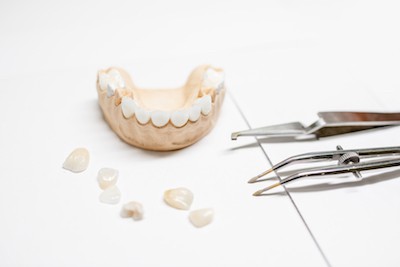
11 May The Difference Between Porcelain and Composite Veneers
Here Are The Differences Between Porcelain and Composite Veneers
If you’re considering cosmetic dentistry to improve your smile, you may have heard the terms “porcelain veneers” and “composite veneers” without having a clear understanding of which one you should choose. Veneers can be used to improve the appearance of a single tooth or multiple teeth, and they are a popular cosmetic dentistry option for those who want to achieve a more aesthetically pleasing smile. They can also be used to close gaps between teeth or to lengthen teeth that appear too short.
So what is the difference between porcelain and composite veneers? Let’s break it down.
- Material: Porcelain veneers are made of thin, custom-made porcelain shells placed over the front of the teeth. Composite veneers, on the other hand, are made of a tooth-colored resin material that is bonded to the front of the teeth.
- Durability: Porcelain veneers are more durable than composite veneers and can last up to 15 years or more with proper care. Composite veneers are less durable and may need to be replaced more frequently, typically every 5 to 7 years.
- Appearance: Porcelain veneers have a more natural and translucent appearance, mimicking the look of natural teeth, while composite veneers can look more opaque and less natural.
- Preparation: Porcelain veneers require more preparation of the teeth before they can be placed, as a thin layer of enamel needs to be removed to make room for the veneers. Composite veneers require less preparation and may not require any enamel removal.
- Cost: Porcelain veneers are generally more expensive than composite veneers due to the materials and preparation required.
Ultimately, the choice between porcelain and composite veneers depends on individual preferences and the specific needs of the patient. Read on to learn more about veneers and which type might be right for you.

Overview Of Porcelain And Composite Veneers
Porcelain and composite veneers are popular in cosmetic dentistry due to their ability to repair various imperfections in teeth, resulting in a beautiful, dazzling smile. Porcelain veneers consist of thin layers of porcelain attached to the front of teeth, while composite veneers are made of resin material. Both types of veneers can be used to cover chipped or cracked teeth, fill in gaps between teeth, and even alter the shape and size of teeth.
Unlike traditional crowns, veneers require minimal reduction of the natural tooth structure and can often be completed with just a few visits to the dentist. With proper care, porcelain and composite veneers can last for many years, making them a worthwhile investment for those looking for a smile transformation.
Pros And Cons Of Each Type Of Veneer
Neither option of veneer are a perfect choice for everyone, so it’s important to know the difference between porcelain and composite veneers and consider the pros and cons of each before making a decision.
Porcelain Veneers:
Pros – Natural look, can last up to 15 years with proper maintenance, less tooth preparation required.
Cons – More expensive than composite veneers.
Composite Veneers:
Pros – Less expensive than porcelain veneers, minimal tooth preparation required.
Cons – Not as durable and may need to be replaced more often and have a less natural appearance.
Cost Difference Between Porcelain and Composite Veneers
If you’re trying to decide between two different types of products, it’s important to consider the related costs. Porcelain veneers generally cost more than composite veneers due to the materials and preparation required.
Porcelain veneers cost between $800-2,500+ per tooth, while composite veneers typically range from $250-1500+ per tooth. It’s important to note that these costs can vary based on factors such as the number of veneers needed, the complexity of the case, and the dentist’s experience.
However, even though composite veneers are typically less expensive than porcelain, they may need to be replaced more frequently due to their shorter lifespan. Also, there is a greater chance of staining with composite veneers than porcelain, which would require further cost for replacement.

How Does A Veneer Procedure Work?
The procedure for getting porcelain or composite veneers is relatively straightforward and typically takes 2-3 visits. During the initial consultation, your dentist will examine your teeth to ensure that you are a good candidate for veneers. Then, any necessary treatments such as teeth whitening or cavity filling may be done prior to applying the veneers.
On the second visit, your dentist will take an impression of your teeth and send it to a laboratory where the veneer is crafted. Your dentist will also remove some enamel from the tooth surface in order to make room for the veneer. Once the veneer is ready, your dentist will place it onto the tooth and make any necessary adjustments.
Finally, on the third visit, your dentist will check that the veneer fits correctly and may fill in any gaps or irregularities with dental cement. After that, your new smile is complete!
Maintenance For Porcelain And Composite Veneers
There aren’t many differences between porcelain and composite veneers when it comes to maintenance. It’s important to brush twice daily with fluoride toothpaste and floss regularly in order to keep the veneers looking their best. Additionally, avoid biting into hard objects like ice, nuts, or candy to prevent any damage.
You should also be sure to visit the dentist for regular checkups and cleanings as veneers can still have plaque build-up. Your dentist may also recommend periodic polishing or professional cleaning to remove any buildup or discoloration. With proper care, your porcelain or composite veneers can provide you with a beautiful, confident smile for years to come.
Alternatives To Getting Veneers
If you’re not sure that veneers are the right choice for you, there are a few other options to consider. Teeth whitening treatments can be used to remove surface stains and brighten the teeth up to several shades lighter. You could also opt for dental bonding or crowns if your cosmetic concerns are more severe.
In addition, if you’re looking for a less invasive option, orthodontic treatments such as Invisalign can help to straighten and align the teeth without the need for veneers. Ultimately, it’s important to discuss all available options with your dentist before making a decision.

The Bottom Line
Porcelain and composite veneers are both great options for achieving a straight, beautiful smile. When you make the decision to get veneers, you should weigh the advantages and disadvantages of each kind, compare costs and consider the established procedure for placement and maintenance. The procedure for veneers may take some time but it is safe and effective.
With proper care, veneers can last a long time, giving you years of enjoyment with your beautiful smile. Remember that taking good care of your teeth is essential before and after you receive veneers; visiting the dentist regularly will keep your mouth healthy while ensuring that your smile remains bright. Whether you choose porcelain or composite veneers, you’re sure to love your smile again!
Related Questions
Will dental insurance pay for veneers?
Many dental insurance plans may cover some portion of the cost of veneers, though this will vary based on individual plan and provider. However, it’s important to check with your insurer beforehand to find out what is covered and what portion you are responsible for paying.
Are there any risks associated with getting veneers?
While veneers are generally considered a safe and effective treatment for improving the appearance of your teeth, there are some risks associated with this procedure. These include sensitivity to hot or cold temperatures, temporary nerve damage, enamel damage, and gum irritation. It’s important to consult with your dentist before deciding if veneers are right for you.
Can I remove my veneers?
In some cases, it may be possible to remove your veneers. However, this should only be done by a dental professional as the procedure can be complex and requires precision. Removing your veneers may also cause damage to the underlying teeth structure.





Sorry, the comment form is closed at this time.